LOWER PART COUNT/ALTERNATE "PROTOTYPE" PAINT SCHEME VERSION HERE - 332 parts. Maintains all functionalities except for the custom torpedoes (and the reconaissance cameras, which were a last-second addition).
EDIT: I have spotted a small issue with this plane. After I added the tail markings, an attachment issue caused the cosmetic rudder to not turn - this does not affect the performance of the plane, but if it irks you, here is an updated version fixing this issue.
First of all, as you may have noticed this aircraft has a functional dive-bombing sight and for this I must give an enormous thank you to SnoWFLakE0s. Not only was his work what inspired me to do this on the first place, he was also of invaluable help in guiding me around the "Funky Trees" - I cannot stress this enough. I had started to calculate everything myself but after having severe issues with the calculation of an angle (which happens to be exactly the angle he calculated for his system; I wanted to calculate it myself for the sake of it, but later decided it wasn't worth the effort after several wasted hours), I decided to take the input statement he used in his bombsight and, with a few minor modifications, inserted it into the input statement for this system here, which due to its nature needs a little bit extra trigonometry on top of that - so I also owe him credit for putting and end to my pain trying to make this work. If you would like to know more, you can take a look at it here.
Again, were it not for his help and the work he's already done, I would likely have given up on this system (at least for the moment) and released the plane without this, using a simple fixed sight instead. It's not necessary for the plane to perform in any way, but it is certainly a very nice addition and this plane was actually built specifically to use it. So, huge shout-out.
Let's get this going, then! This is my third and therefore last entry to the 1945-50 Naval Aviation Challenge. I must say, I didn't expect to do a third one but the idea just popped up in my mind and I had to do it. I've been having a blast with this challenge! For this one, the main inspiration was... A bit of everything, really. There's a bit of D.H. Hornet, a bit of Ki-83, a bit of P-38, a bit of Me 410, and maybe a bit of Tigercat, but mostly it was me piecing together features I liked into a plane on the spot. I hope you enjoy it!
I actually designed this aircraft with a "mission" in mind: Take off from the USS Beast, navigate to the WWII fleet, sink the carrier (and prefferably the two destroyers as well) and fly all the way back home, landing in one piece - all in cockpit view with no in-game HUD. For this purpose, I have made a set of instruments for this aircraft, which I like to call semi-functional: They work (Thanks, Funky Trees) but you can't get quick/accurate readings out of them. Still, it is possible to do, and for those interested I shall dedicate an entire section to explain the instruments and how to carry out this "mission"!
And for those of you with little time or who simply do not wish to read too much, I will place a line where the really boring part (extra notes and backstory) start, so you only have to read the necessary stuff. Or, you could just read the controls section below and hop in the cockpit without a care in the world - it is forgiving and docile in handling. Your choice.
Controls:
AG 1: Deploy Dive Brakes
AG 2: WEP (War Emergency Power, methanol-water injection boost)
AG 3: Jettison External Fuel Tanks
AG 4: Jettison/Drop Inboard Bombs
AG 5: Jettison/Drop Outboard Bombs
AG 6: Dive Sight On (See: Dive Bombing Procedure - Gunsight Usage)
AG 7: Tail Hook Down
AG 7 + VTOL DOWN: Wing Folding
AG 8: Nav Lights On/Off
VTOL UP: Flaps Down
TRIM: Trim (Note it is now very sensitive.)
Note that torpedoes cannot be jettisoned with AGs. If you need to ditch them, select them as weapons and hold the fire button for a while - in a quarter of a second, both torpedoes will be off.
Cameras 1 and 2: Port and Starboard side-looking reconaissance cameras
Dive Bombing Procedure - Gunsight Usage
- Turn off advanced targeting, that wouldn't be any fun! This sight is sufficiently accurate but it is not easy mode - you require certain parameters in order to employ it to the full extent of its capabilities.
- Turn on the dive sight (AG 6)
- Begin your dive on the target. You may use dive brakes (AG 1) if your speed is too high, but remember bombing accuracy increases the faster you are. It also increases as your dive angle becomes more steep and as the altitude lowers.
- As you dive, you will notice a second bar popping up in the reticle. This is the bar you will align with your target to drop the bombs. If the bar stays still at the "bottom" of the sight, that means the impact point is not within the viewing zone of the sight yet.
- Remember the gunsight does not account for roll, lateral movement or pitch acceleration. Keep your roll as close to zero as possible and watch the slip indicator for any unexpected deviation.
- As you pull your sights on target, you will probably be constantly exerting some force to keep the aircraft pointed where you want it to. Remember the sight does not take this into account, so if you're bombing a small target from considerable altitude, do the following: as your sight approaches the target, let go of the stick completely (right click the mouse button to deactivate mouse-joystick). Unless you're somehow at very low speed in a dive, the sights will naturally cross the target and when they do, release the bombs (remember AG 4 and AG 5 for quick releases). It is best to not use dive brakes during this procedure.
- Note: Should you decide to select the bombs and launch them individually, know they have a firing delay of 0.25 seconds. Just tap the button if you want to drop a single bomb, or hold it for ripple-firing them.
- Note: The bombs do not have any extra force pushing them out of the pylons! Pitch up as soon as the bombs are released in order to clear the aircraft. Never pitch the aircraft down right after releasing bombs.
- This system takes AGL (Altitude Ground Level) as an input - this might make it spotty and unpredictable over mountainous terrain.

Proper firing solution.
Instruments:

- The altimeter has three pointers: The long white one completes a turn each 100 feet. The thicker, stubbier one completes a turn each 1,000 feet, and finally the thin red one completes a turn each 10,000 feet. You can actually use this to have a very solid idea of what altitude you're in as long as you keep track of how many times the red pointer has completed a turn.
- The airspeed indicator "tops off" at around a very optimistic 500 knots IAS: Let me know if you somehow managed to exceed this.
- The heading indicator and the artificial horizon have the same problem: Due to the way the input system is arranged, if they cross the "180 degree" line, they will turn around to the other side abruptly rather than just continue. Tell me if you know of a way to go around this.
- When flaps are fully down, the flap indicator will point down 45 degrees. When flaps are fully retracted, it will be level.
THE LINE
This is the line I talked about in the introduction. Below this point you will find only screenshots and boredom. You have been warned.
Torpedo Bombing Procedure:
- This aircraft uses a custom shell for the torpedoes, just for aesthetics. However, the nature of the torpedo in SimplePlanes makes this "casing" behave weirdly once the torpedo hits the water, standing "upright" in the water - this is a known issue I've scourged the forums for, and no solution seems to exist. in some circumstances, this can completely throw off the torpedo's trajectory, but if it is thrown with good parameters - which surprisingly approaches the conditions torpedoes needed in real life - it is more than accurate enough. The procedure is as follows:
- Select the Torpedo weapon.
- Initiate your attack run. Be wary of target movement - start leading now, trying to correct this in the last moments with excessive rudder will throw your torpedo off mark.
- fly as low as possible. You don't need to be grazing the water with the propellers, but try to stay below 100 feet if possible.
- Keep your wings as level as you can. You can roll your aircraft to take aim, but for launching the torpedo it's best to have them level. A slight amount of roll is acceptable, however.
- Most important of all - be wary of slip, especially if you're using rudder. This is the main reason why this aircraft has a slip indicator. Keep it as close to zero as you can.
- Once you are confident of your firing solution, release the torpedoes. Note: They have a firing delay of 0.25 seconds, so just tap the button if you wish to fire just one, or hold it for quick-firing both.
"Mission": Sinking the WWII fleet in cockpit view with no HUD
- Press F9 to hide the game's interface. Spawn on the USS Beast, either on the catapult or on the deck, in the weather and time of your choosing.
- Flaps down 1/2, full throttle and WEP on (AG 2) for takeoff. You may choose to either launch from the catapult or on your aircraft's own power.
- After taking off and gaining sufficient speed, turn WEP off. Turn to heading 012 degrees. Your heading indicator should look like this:

- Maintain heading 012 and climb to around 15,000 or 20,000 feet (count either 1+1/2 or 2 complete turns of the thin red pointer in the altimeter). Upon reaching the desired altitude, decrease throttle to a cruise setting of about 70%. Your throttle gauges should look like this:

You can use a slight amount of flaps for trimming without switching the game's interface on. - Maintain heading and altitude until you spot the island of Kraklaboa on the horizon. At this point, if your heading is a bit off, adjust your course visually so you will pass around the center of the island.
- Upon passing over the center of the island, take heading 355 and descend to 10,000 feet. Your heading indicator should look like this:

- Keep an eye out for the enemy fleet - it might not be exactly in front of you. Upon spotting it, initiate the attack run at your discretion. (See Dive Bombing and Torpedo Bombing Procedures sections to obtain maximum effectiveness from your weapons system)
- Remember: you are bombing point targets and your sight system isn't perfect. While in real life a bomb which detonates in the water right next to a ship will cause massive damage, in SimplePlanes a bomb that hits the water does nothing. As such, it is paramount that you be extremely accurate, dropping the bombs as fast and as low as possible; practice dive bombing using the sight to get the hang of aiming just at the right spot.
- Upon finishing your attack run, egress back towards the island of Kraklaboa. You should be able to spot the island visually, but if weather conditions do not allow this, take heading 175. Your heading indicator should look like this:

- Upon crossing the island, take heading 190 and climb to about 15,000 feet.

- You should be able to spot the friendly carrier fleet in due time. If weather conditions are not favorable, descend to an altitude where you will have a better chance of spotting the fleet.
- Initiate your landing approach. It is recommended to jettison any unused ordnance, but this is not necessary. There is no need to jettison the external fuel tanks in case you haven't already done so. As soon as your aircraft catches the wire, pitch up - you might suffer a propeller strike if you fail to do so.
- You are safe back home! Mission accomplished!

Backstory and Design

Top: Ciclone in air-to-air configuration. Bottom: Fully loaded anti-ship configuration. Note the two supplementary hardpoints for torpedoes.
Developed for use in the Pacific theatre of operations, the S. Ca. 132 Ciclone (Cyclone) arrived too late to see combat in WWII, but it was nevertheless quite the feat for its time. Though as with all of its "superprop" bretheren it was to be soon replaced by jet-powered craft, it remains near the pinnacle of advancement for piston-powered aircraft.
The first prototype flew in late 1944, and the aircraft would enter service mid-1946. It remained in service through the early 60's, albeit in secondary roles.

Prototype in flight
The Ciclone was meant to be a multi-task aircraft, capable of carrying out both strike and long-range fighter duties, making the most out of the space it occupied in a carrier. Though its primary mission was attacking hostile shipping, a great deal of effort was spent in making the aircraft capable of high-altitude air-to-air combat. To this extent, it is powered by two 18-cylinder, two-row turbosupercharged radial engines providing 2000 horsepower each at military power (100%) - This could be further boosted by a water-methanol injection system for takeoff and combat. The engines drive two counter-rotating four-blade automatic pitch propellers, and the area behind them is occupied both by the main landing gear and by the rather elaborate turbosupercharger.

Diagram/sketch showing the turbosupercharger system for one of the engines
The wings feature a folding mechanism, which along with the engine nacelle requires the flaps to be divided in three separate sections. The aleirons are sizeable and allow the aircraft to attain a roll rate uncommon for twin-engine aircraft.

A prototype lands after a test flight.
When flying clean, the aircraft's sleek lines do not lie - it was designed for performance, through and through. Air intake area was minimized to reduce drag, requiring the installation of fans to help cool the engines. The thin fuselage housed an ample canopy near its very nose, providing the pilot with excellent visibility. The aircraft's large wings provide it both with great payload capacity and excellent maneuverability for an aircraft of its size - it was reportedly able to face single-engine fighters in the vertical plane during mock dogfights.

One of the Ciclone's best angles. Note the supplementary hardpoints for torpedoes attached under the fuselage

The aircraft's smooth design is apparent in this top view.
The gun bays on the aircraft are designed in a modular manner; they can be swapped out without need to retrofitting or retooling, allowing a wide array of weapon configurations. A common one for strike missions is four .50 caliber machineguns, as seen here, plus two supplementary 37mm autocannons requiring blisters under the nose. These optional supplementary weapon packages allowed the aircraft to be extremely flexible in various types of ground attack missions, although for air-to-air combat they were rarely fitted; instead, the most common configuration in that scenario was four 20mm cannons.

The two protuding barrels from the supplementary 37mm cannons can be seen in this picture
In late 1945, a Ciclone prototype was sent out to test the effectiveness of the newly-installed 37mm guns on aerial targets. Upon firing at its target, a radio-controlled decomissioned bomber, the aircraft was struck by shrapnel, so potent was the explosive charge in the rounds. The shrapnel struck the left engine, causing considerable damage - while the engine was still running, the chase plane noticed sizeable flames coming out of the supercharger waste gate, prompting the pilot to cut off power and fuel supply to the engine immediately. The fire was eventually extinguished and the aircraft was able to safely fly and land back home in a single engine, proving the aircraft's survivability to damage.


The Ciclone heads back to base with one engine knocked out.
A stable weapons platform, the Ca. 132 was soon to be found flying in all sorts of roles. Among its core missions were: Dive boming; Torpedo bombing; Close Air Support; Interdiction; Armed Reconaissance; Combat Air Patrol; Fighter Sweep; Interception; and Escort. It was a sturdy and reliable aircraft, able to withstand harsh carrier landings and maneuvers while carrying heavy payloads.

A Ciclone slams down on deck.
On the external payload department, the Ciclone was most usually fitted with six hardpoints, normally carrying four bombs and two external drop tanks. However, two additional "supplementary" hardpoints could be fitted under the fuselage, allowing for two more bombs, drop tanks or torpedoes to be carried. With four bombs and two torpedoes, the Ciclone suffered somewhat on performance and range but still remained perfectly capable of carrying out its mission.

Ciclone in full anti-ship loadout.
Despite being an excellent torpedo bomber, the Ciclone was designed with dive bombing as its main method of attack. For this purpose, the aircraft is fitted with dive brakes and what was at the time a state-of-the-art dive bombing gunsight, the VBM-2A (Visor de Bombardeio em Mergulho, Dive Bombing Sight) - this device was based around an analogic computer linked to the aircraft's instruments, feeding on their data to calculate a bombing solution displayed on a reflector sight to the pilot. This gave the Ciclone unparelled effectiveness in bombing compared to other aircraft of its era.

A prototype launches two 750-pound bombs at a decomissioned target vessel.
As the aircraft was supposed to be able to operate in all weather conditions, at day or night, provisions were made so that aircraft could be fitted with supplementary "pods" on the outboard wing sections for extra equipment. A common configuration in dedicated night attack squadrons was one radar pod on the starboard wing and a searchlight on the port wing, which could be slaved to the radar.

Carrier approach at night
Production aircraft were fitted with plexiglass "windows" on the sides of the fuselage - there cameras could be housed for reconaissance missions if necessary, further enhancing the aircraft's flexibility - and cost. While care had been taken during its design to make the lives of maintenance crew easier, it was still not the easiest plane to maintain, with the complex turbosupercharger requiring a good deal of care. This meant the aircraft was not too much cheaper or easier to maintain when compared to a jet-powered airplane, a factor which contributed to its replacement in front-line duty by the Marreco.

The starboard side "camera window" can be seen in this side view.

*Here, the side-looking cameras of a Ciclone spot a truck convoy travelling through the desert.
Nevertheless, these planes continued in service up until the 60's, mostly in second-line, shore-based duties but also a handful as torpedo platforms, bomb trucks and low-altitude tactical reconaissance aircraft. The aircraft's reliability, sturdiness and immense flexibility made it a valued asset by naval aviators and commanders.

A prototype test-fires a torpedo.
Shown here is an aircraft flown by Naval Attack Squadron 7, "Relâmpago" (roughly "thunderflash").

Gallery:







Specifications
Spotlights
- This craft has been featured
- GrizzlitnCFSP 5.7 years ago
- Strikefighter04 5.7 years ago
- Freerider2142 5.7 years ago
- SnoWFLakE0s 5.7 years ago
- ACEPILOT109 5.7 years ago
- Armyguy1534 5.7 years ago
General Characteristics
- Predecessor 1945-1950 Naval Aviation Challenge (Closed)
- Created On Windows
- Wingspan 52.9ft (16.1m)
- Length 39.8ft (12.1m)
- Height 15.7ft (4.8m)
- Empty Weight 9,245lbs (4,193kg)
- Loaded Weight 17,585lbs (7,976kg)
Performance
- Power/Weight Ratio 1.533
- Horse Power/Weight Ratio 0.227
- Wing Loading 36.1lbs/ft2 (176.2kg/m2)
- Wing Area 487.4ft2 (45.3m2)
- Drag Points 5943
Parts
- Number of Parts 429
- Control Surfaces 9
- Performance Cost 2,102

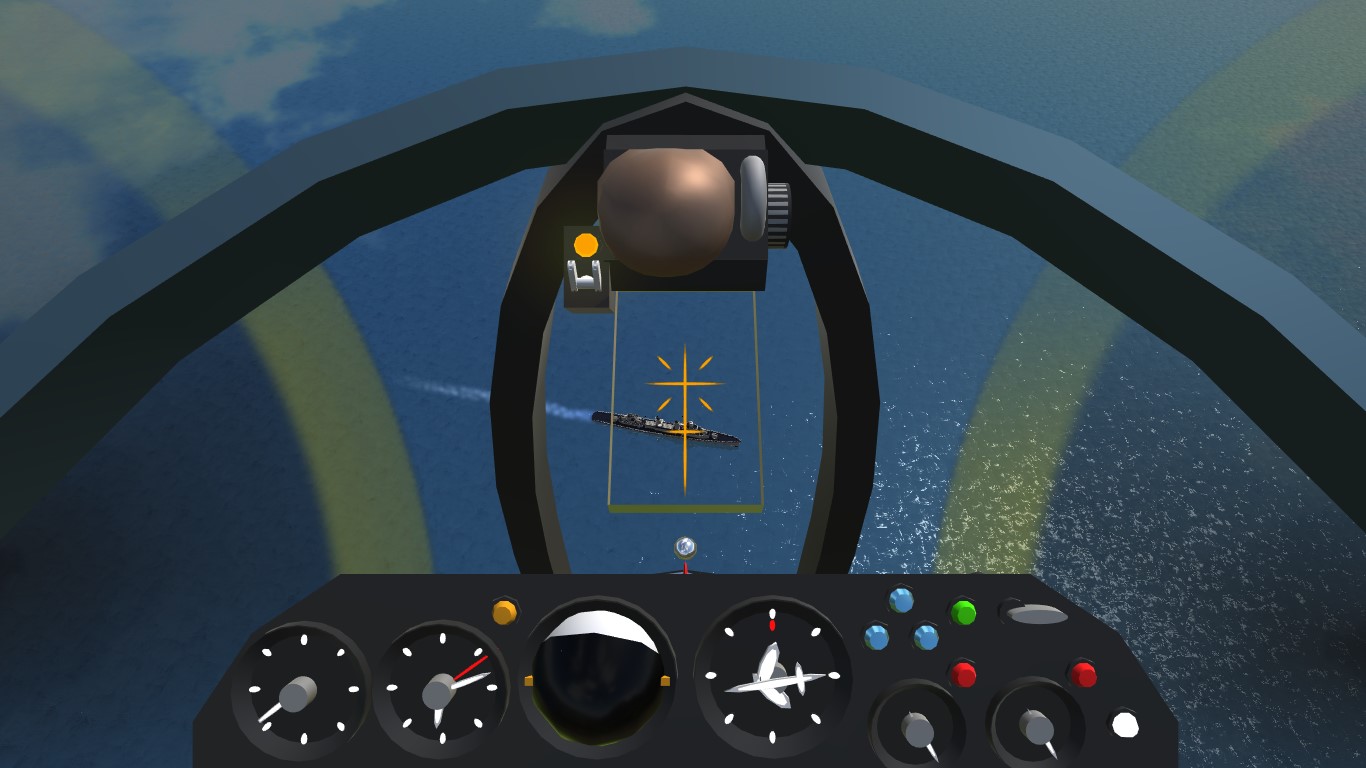
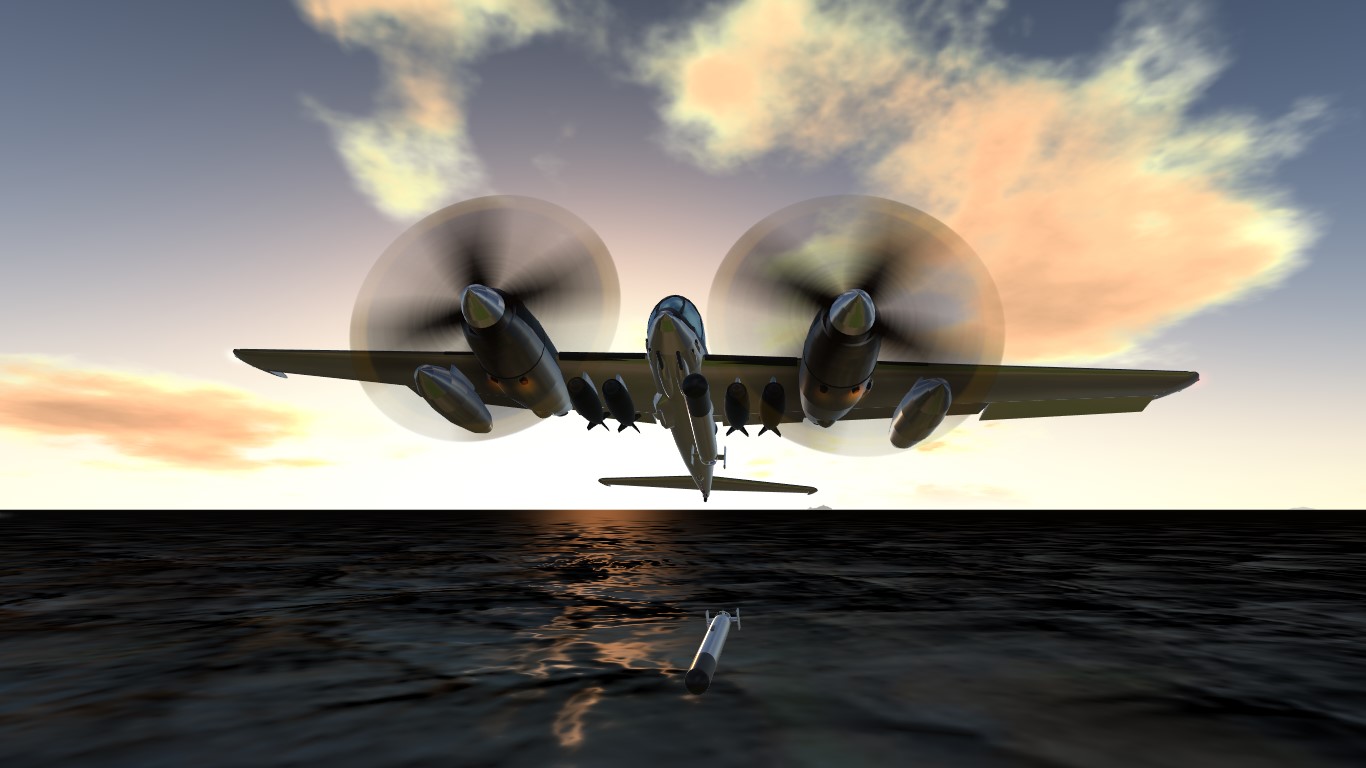
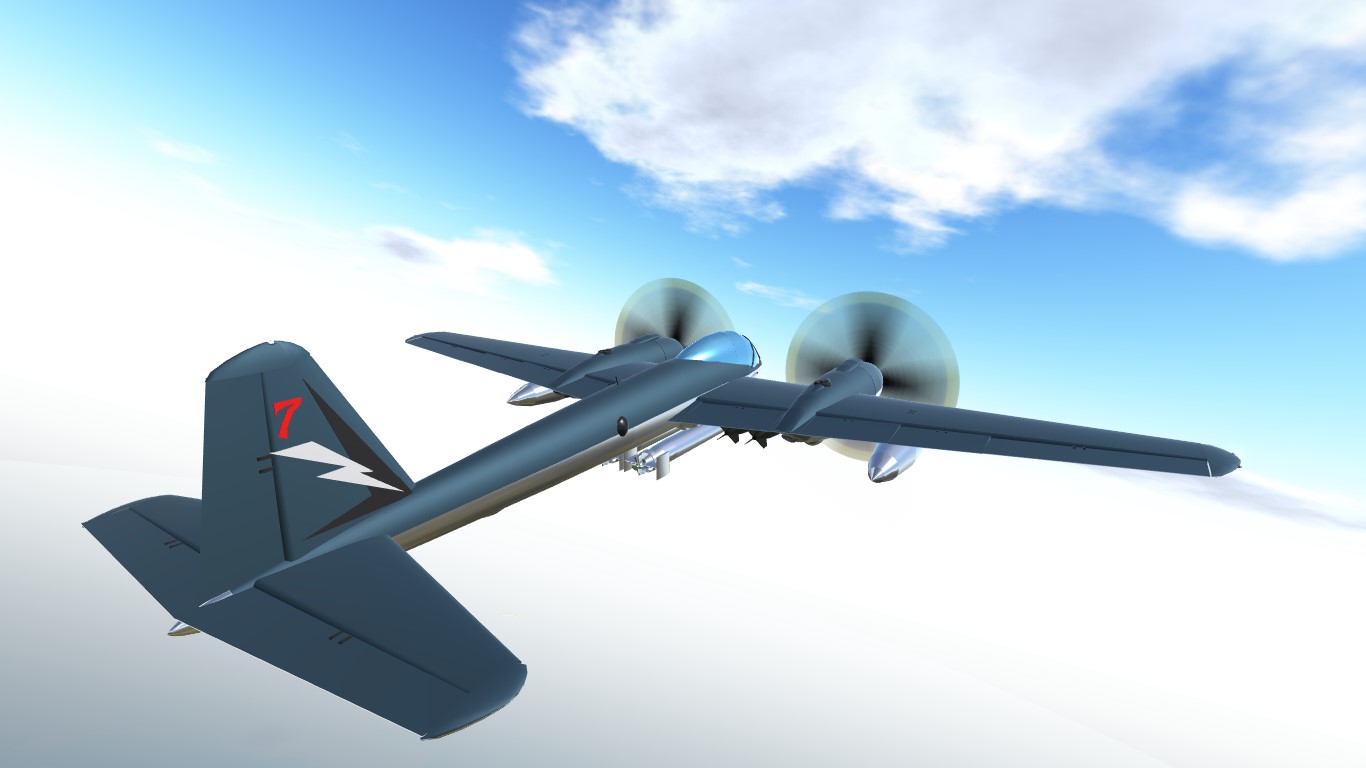
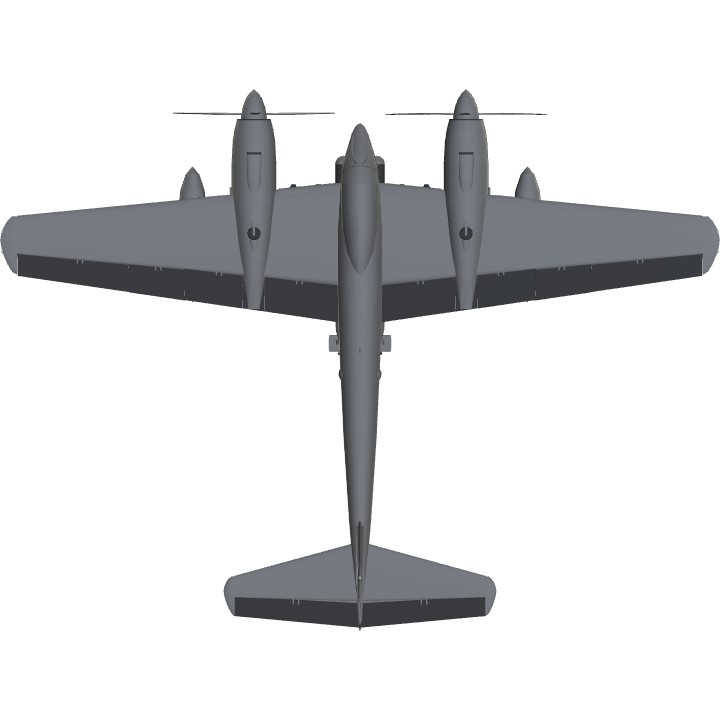
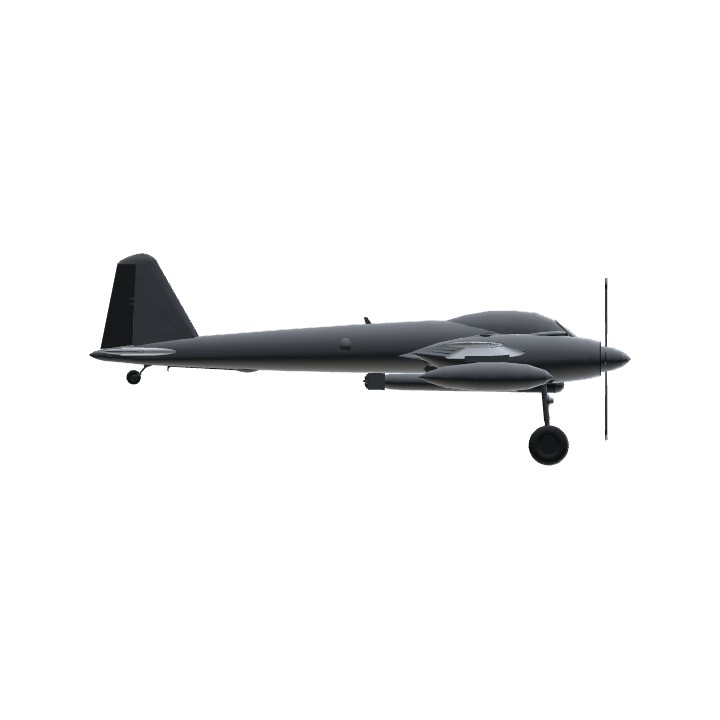
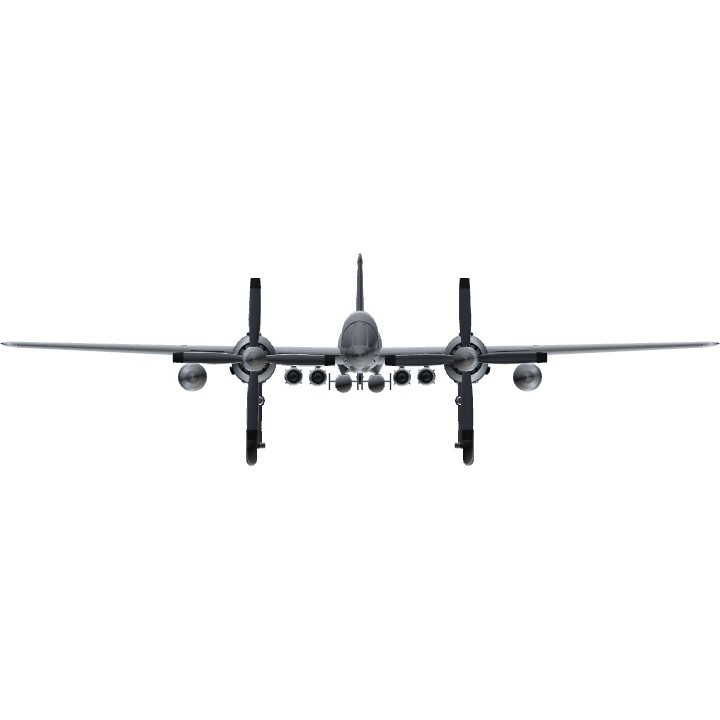
Nice TutorialPlane on steroid
@FlyingHueman And yes, it’s got an absolute ton of lift, which is great!
@FlyingHueman Yeah, that happened to me once! Lol.
@wonkapilot Haha, it's got a heck ton of lift doesn't it? The real hard thing is landing this thing with an engine out, though. I did the "mission" I laid out there several times, in one of them the ships shot one of my engines out. I flew back home on a single engine, but when I was approaching for landing I went too slow and my rudder started losing authority. Desperate, I throttled up - and the asymmetric thrust sent me in a flatspin to the ocean, lol.
Btw it was with full payload when I did it.
@FlyingHueman I landed this on the USS Beast without the arrestor hook down, and then I did it without the arrestor hook or the flaps down! It’s amazing!
Yeah I’d agree man, you really need to cool down after that build, take care. @FlyingHueman
@Alta2809 Well, with over a thousand downloads I don't know if I'd call it underrated, lol. Perhaps some people are just tired of reading/scrolling through the long descriptions to upvote the thing, but they're an integral part of my creative process so they're not going anywhere anytime soon.
And thanks a lot, man! To be fair, I don't think I'm ever going to make something as complicated as that gunsight, lol. I do have some ideas in mind though, but I'm cooling down for a bit.
@FlyingHueman This build is far too underrated, I've had so much fun with this thing blowing up ships. I can't wait to see more builds like this one by you. Top Job
@DickBrazen Thank you for the comment! I'm glad this was of use to you. About the altimeter, one of the big issues I had here was how I was having to work with small parts, which can get really annoying at times. I really wouldn't want to go with pieces much smaller than the ones I used here. Also, altimeters IRL usually work in this way; some only have two hands, for 1000 and 100 feet, but others like this one have three hands for 100, 1000 and 10000 feet, an as far as my research found, usually with a similar hand size arrangement. I did take artistic liberties in making the 10k ft hand red, however, for quicker reading.
@FlyingHueman you deserve it though! Your builds were really fantastic!
@Mustang51 Lol, no need man. I'm already more than happy with just having taken part on it.
Nice!
So I’ve upvoted all your aircraft but you still need around 8 more upvotes. If you would like I can just upvote your new posts or I can spotlight a few aircraft of your choosing. It will take a few days to do that but it’s probably the better option
And here are your results for this final build!
Design: 18/20
Functionality: 9/10
Performance: 10/15
Build quality: 15/15
Paint scheme: 4/5
Personal opinion 5/5
Overall: 61/70 (6 upvotes!)
Ide decline being the pilot lol: Anxiety 100 @FlyingHueman
@Zanedavid Thanks! Yeah, I should probably have set them a bit further apart, but look on the bright side - they're in front of the cockpit, so if the propellers suffer some catastrophic failure they're not flying at you. If you want something really stress-inducing, look at the IA 58 Pucará... That thing has the propellers almost grazing the canopy and in-line with the pilot. It was actually used as an example of "do not do this" in a conceptual aircraft design book I read a long time ago.
Really like the working cockpit features, nice work, the propellers are a bit stressful to watch when they are that close together, either way nice job @FlyingHueman
@Ardanikova yes
I haven't even used 50% of my power yet
Ok hope to see some good planes@FlyingHueman
what a very short description
@Giantwhale I've been thinking about that since the update came out but I have a long list of other things I want to do first.
@ChisP Some of my other builds might have a thing or two to say about that, lol.
Or a tanker would be cool
Longest description in sp history right here 😂
You should make a updated version of the Anaconda bomber that would be really cool and I would upvote that!